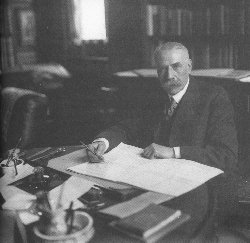|
Two concertos for the cello are performed more often than any
others. One is by Antonin Dvorak, an epic work brimming with melodies and
embracing a wide range of emotion. The other is Elgar's: intimate, highly-concentrated
and unlike any other ever written for the instrument. Pablo Casals, Paul Tortelier,
Jacqueline du Pré and Yo-Yo Ma are among the cellists who have made landmark
recordings of Elgar's concerto, and memorable new interpretations continue to
appear. The concerto may be the work of Elgar's with the most universal appeal, but,
paradoxically, it is the work of his that is most rooted in a specific moment in
time.
 |
Elgar at work
in Severn House in 1919,
the year in which
he composed the concerto
|
|
Elgar wrote the concerto in 1919, just after the Great War. Appalled and disillusioned by
the suffering caused by the war, he realized that life in Europe would
never be the same after such destruction. His first reaction had been to withdraw from
composition, and he wrote very little music during the war's first four years. Then,
over a period of twelve months - from August of 1918 to the following August - Elgar
poured his feelings into four works that rank among the finest he ever composed. The
first three were chamber works in which he developed a new musical voice, more
concise and subdued than his previous one. The fourth work was the Cello Concerto,
Elgar's lament for a lost world. A complete guide to Elgar's Cello Concerto can be
found by visiting the following pages.
|